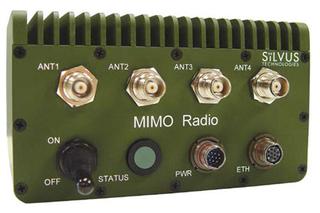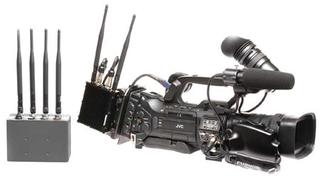Doug Lung on ATSC 3.0, Two-Way ENG and New Mic RFs
As we start a new year, I thought it would be a good time to take a look at new technology trends. Three areas that attracted my attention are ATSC 3.0 (no surprise), two-way ENG and new technology for wireless microphones. After this year’s spectrum auctions, it’s expected that the number of vacant VHF and UHF channels available for wireless microphones will shrink as TV stations are tightly packed into a limited number of UHF channels and some stations move from UHF to VHF.
ATSC 3.0 ARRIVES
I’ve been writing about ATSC 3.0 for a while, but 2016 should be the year the standard finally arrives. As I’m writing this in late December, there are now six ATSC candidate standards available at www.atsc.org/candidate-standards. Last month the ATSC announced that it was conducting demonstrations of ATSC 3.0 over-the-air technology from multiple companies at CES and I’m also sure the standard will be rigorously tested in the lab and the field this year.
Some of the things I hope will happen in 2016, or soon thereafter, are the start of an FCC process to allow broadcasters to transition to ATSC 3.0; agreements among broadcasters on how to transition to ATSC 3.0 while preserving ATSC 1.0 signals for existing over-the-air viewers; and commitments by transmitter companies to make the equipment to transmit ATSC 3.0 and by consumer electronics manufacturers to include ATSC 3.0 in a range of products. ATSC 3.0 won’t be available to consumers in 2016, but we should see one or more “model” stations on the air to give broadcasters and device manufacturers a chance to demonstrate its capability.
TWO-WAY ENG
ENG crews have gotten used to the convenience of using 4G wireless networks to send stories, live and recorded, from the field to the studio. It isn’t surprising that companies are looking to make newsgathering using broadcasters’ own 2 GHz spectrum just as easy. This will require two-way communication, which could complicate deployment in markets where 2 GHz spectrum is heavily used. Even if the system can work on one channel—perhaps by using time domain multiplexing—other broadcasters are not likely to appreciate having a transmitter on an adjacent channel at popular ENG receive sites.

Silvus Technologies’ MIMO radio As with the transition to ATSC 3.0, it will be essential for broadcasters in a market to work together if two-way ENG is to replace today’s one-way truck to ENG receive site model. Two companies taking two different approaches demonstrated their technology at CCW (now called “NAB Show New York”) last November. Silvus Technologies showed a private MESH network using the Mobile Ad-Hoc Network (MANET) multi-hop IP packet-based wireless networking technology, which they first announced at the 2015 NAB Show. The nodes, which could include a mobile unit on the back of a camera; portable units on the mast of ENG trucks; and fixed units on the roofs of buildings form a mesh where any node can communicate with any other node, even if the data has to pass through other nodes on the way.

JVC camera with MESH transmitter/radio in use There is no need to aim dishes and if nodes can see more than one other node, the system becomes self-healing should one node go down. The Silvus Technologies equipment is compact, making it easier to set up temporary networks for certain events. Additional details are available in this whitepaper: http://pro.jvc.com/pro/pr/2015/nab/JVC_PrivateMESH_WhitePaper.pdf.
Silvus Technologies gear is already being used for military and government operations and has been successfully used to provide live, moving camera coverage from sporting events like endurance races where conventional microwave links break. This may be the year the technology moves into the street for live ENG. The Silvus Technologies website, http://silvustechnologies.com, describes their products and applications.
The Moseley AxxceLTE radios are based on the LTE standard, which could make them a solution for a shared, market-wide ENG system. Conceivably, broadcasters in a community could set up their own LTE network and if it is standards-based, it should work with LTE-compliant radios from other vendors’ LTE-based ENG systems we might see at the 2016 NAB Show. One complication is that LTE requires a management computer to control access and allocate spectrum. I had pictured this as a high-powered server, so I was surprised to see the Moseley Broadcast demonstration at CCW running on a little Linux box.
A bit of Googling found OpenLTE— http://sourceforge.net/p/openlte/wiki/Home. This is an open-source implementation of the 3GPP LTE specifications. With a transmit/receive SDR like the Ettus B2XX you can build your own OpenLTE eNodeB. I hope to have some time to play with that this year and learn more about LTE.
You can learn more about Moseley’s plans for LTE in their 2015 NAB Show press release: http://moseleysb.com/mb/pdf/Ax-cellLTEBAS_PressRelease.pdf.
NEW FREQUENCIES FOR WIRELESS MICS
A hot topic at a meeting last month was the impact of the loss of 600 MHz TV spectrum after the incentive auction on everything from live news coverage to the production of major sporting events and Broadway shows. The analog shutdown resulted in the loss of 18 TV channels widely used for wireless microphones. Anyone using wireless microphones on these channels found them obsolete and illegal.
The same thing will happen after the incentive auction as TV spectrum will again be reduced. Fourteen TV channels will probably go away. If the FCC efficiently packs the remaining VHF and UHF spectrum, there won’t be enough TV channels for the wireless microphones in use today.
Wireless microphone companies are developing products for alternative spectrum— 1.4 GHz and/or 5.0 GHz. A replacement for the analog FM technology used today for wireless microphones will be needed to take advantage of the limited spectrum and provide high-quality sound without dropouts. Swapping out existing wireless microphone equipment will take time, so prudent broadcasters and production companies will start looking for solutions this year.
2016 will be an interesting and challenging year, but new technologies are appearing that will help the broadcasters that don’t sell out in the incentive auction. Look for those technologies in a few months at the NAB Show. I’ll be writing about them in this RF Technology column and on other postings on www.tvtechnology.com.
Comments are welcome! E-mail me atdlung@transmitter.com.
Get the TV Tech Newsletter
The professional video industry's #1 source for news, trends and product and tech information. Sign up below.
Doug Lung is one of America's foremost authorities on broadcast RF technology. As vice president of Broadcast Technology for NBCUniversal Local, H. Douglas Lung leads NBC and Telemundo-owned stations’ RF and transmission affairs, including microwave, radars, satellite uplinks, and FCC technical filings. Beginning his career in 1976 at KSCI in Los Angeles, Lung has nearly 50 years of experience in broadcast television engineering. Beginning in 1985, he led the engineering department for what was to become the Telemundo network and station group, assisting in the design, construction and installation of the company’s broadcast and cable facilities. Other projects include work on the launch of Hawaii’s first UHF TV station, the rollout and testing of the ATSC mobile-handheld standard, and software development related to the incentive auction TV spectrum repack.
A longtime columnist for TV Technology, Doug is also a regular contributor to IEEE Broadcast Technology. He is the recipient of the 2023 NAB Television Engineering Award. He also received a Tech Leadership Award from TV Tech publisher Future plc in 2021 and is a member of the IEEE Broadcast Technology Society and the Society of Broadcast Engineers.

